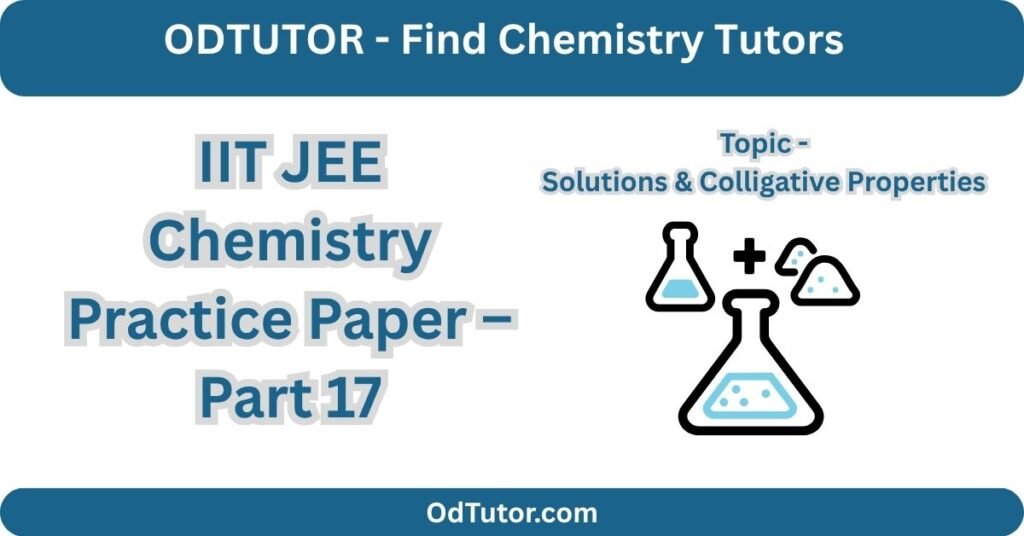IIT JEE Chemistry Practice Paper – Part 17: Solutions & Colligative Properties
Topic: Solutions & Colligative Properties
Type: Multiple Choice Questions (MCQs)
Marks: +4 for each correct answer
Negative Marking: 0 (Practice Mode)
Solutions & Colligative Properties: Notes and Important Formulas
A Strategic Guide for IIT-JEE Aspirants by Prof. Anil Tyagi
My dear students, a solution is more than just a mixture; it is a homogeneous embodiment of molecular interactions. Understanding solutions is crucial, for it leads us to Colligative Properties—those properties that depend not on the identity of the solute particles, but solely on their number. This chapter is a hallmark of conceptual chemistry and a favorite for JEE problem-setters. Let’s build this concept from the ground up.
1. Core Definitions & Concentration Terms
First, we must speak the language precisely.
- Solution: A homogeneous mixture of two or more components. The component in excess is the solvent, the minor component is the solute.
- Concentration Measures:
- Molarity (M):
M = (Moles of Solute) / (Volume of Solution in Litres)- Temperature dependent (volume changes with T).
- Molality (m):
m = (Moles of Solute) / (Mass of Solvent in kg)- Temperature independent (mass is invariant).
- Mole Fraction (x):
x_A = (Moles of A) / (Total Moles in Solution)- For a binary solution:
x_solute + x_solvent = 1
- For a binary solution:
- Molarity (M):
For JEE: Molality and Mole Fraction are preferred for colligative properties as they are independent of temperature.
2. The Foundation: Raoult’s Law
For a volatile solvent in a solution containing a non-volatile solute, the governing principle is Raoult’s Law.
- Statement: The partial vapour pressure of a solvent in a solution (
P₁) is equal to the vapour pressure of the pure solvent (P⁰₁) multiplied by its mole fraction in the solution (x₁). P₁ = P⁰₁ x₁ - For Volatile Solute and Solvent: The total vapour pressure (
P_total) is the sum of the partial pressures. P_total = P⁰_A x_A + P⁰_B x_B - Ideal vs. Non-Ideal Solutions:
- Ideal Solutions: Obey Raoult’s Law over the entire range of concentration (e.g., Benzene-Toluene).
ΔH_mix = 0,ΔV_mix = 0. - Non-Ideal Solutions: Show deviations.
- Positive Deviation:
P_total > P⁰_A x_A + P⁰_B x_B(e.g., Ethanol-Water).ΔH_mix > 0, solute-solvent interactions are weaker. - Negative Deviation:
P_total < P⁰_A x_A + P⁰_B x_B(e.g., HNO₃-Water).ΔH_mix < 0, solute-solvent interactions are stronger (e.g., H-bonding).
- Positive Deviation:
- Ideal Solutions: Obey Raoult’s Law over the entire range of concentration (e.g., Benzene-Toluene).
3. The Heart of the Chapter: Colligative Properties
These are the properties that depend on the number of solute particles, not their nature. They are all consequences of the lowering of vapour pressure as stated by Raoult’s Law.
For a non-volatile, non-electrolyte solute:
1. Relative Lowering of Vapour Pressure:
This is the direct application of Raoult’s Law.
(P⁰ – P) / P⁰ = x₂
wherex₂is the mole fraction of the solute. For dilute solutions, it can be approximated as:
(P⁰ – P) / P⁰ = (n₂ / n₁) ≈ (W₂ M₁) / (W₁ M₂)
2. Elevation of Boiling Point (ΔTb):
Adding a solute lowers the vapour pressure, which means a higher temperature is needed to make the vapour pressure equal to the atmospheric pressure.
ΔTb = Kb × m
Kb = (R Tb² M₁) / (1000 × ΔHvap)
Where:
Kb= Ebullioscopic Constant (molal boiling point elevation constant)m= molality of the solutionM₁= Molar mass of solvent
3. Depression of Freezing Point (ΔTf):
The solute disrupts the solvent’s ability to form a solid lattice, thus freezing occurs at a lower temperature.
ΔTf = Kf × m
Kf = (R Tf² M₁) / (1000 × ΔHfus)
Where:
Kf= Cryoscopic Constant (molal freezing point depression constant)m= molality of the solution
4. Osmotic Pressure (π):
The pressure required to be applied on the solution to prevent the inward flow of pure solvent through a semi-permeable membrane.
π V = n R T (Ideal solution form)
π = C R T
Where:
C= Molar concentration (mol/L)R= Gas constant (0.0821 L atm mol⁻¹K⁻¹ for π in atm)T= Temperature in Kelvin
4. The Crucial JEE Twist: The Van’t Hoff Factor (i)
The formulas above are for non-electrolytes. For electrolytes that dissociate (or associate, like benzoic acid in benzene) in solution, we introduce the Van’t Hoff Factor (i).
- Definition:
i = (Actual Number of Particles after Dissociation/Association) / (Number of Particles Initially Taken) - For a solute AxBy dissociating as: AxBy → x A⁺ + y B⁻
i = 1 + (x + y - 1)αwhereαis the degree of dissociation.
- Modified Colligative Property Formulas:
- Relative Lowering of V.P.:
(P⁰ - P)/P⁰ = i x₂ - Elevation of B.P.:
ΔTb = i Kb m - Depression of F.P.:
ΔTf = i Kf m - Osmotic Pressure:
π = i C R T
- Relative Lowering of V.P.:
Professor Tyagi’s Key Takeaways & Problem-Solving Strategy:
- Identify the Solute Type: Is it non-electrolyte or electrolyte? This decides whether you need
i. - Master the ‘i’ Factor: For dissociation,
i > 1. For association,i < 1. This is the most common source of errors. - Osmotic Pressure is the King: For high molecular weight solutes (like polymers or proteins), osmotic pressure is the most sensitive and accurate method for determining molar mass. Remember the formula
π = (w₂ R T) / (M₂ V). - Link the Concepts: Freezing point depression is the most commonly used colligative property (e.g., antifreeze in car radiators, salt on icy roads). Understand why.
- Formula Sheet Ready:
ΔTf = i Kf mandm = (w₂ / M₂) * (1000 / w₁)- Combine them to find Molar Mass (
M₂): M₂ = (i Kf w₂ * 1000) / (ΔTf * w₁)
Internalize these principles. This chapter offers guaranteed marks if your concepts are clear and your calculations are systematic.
Stay disciplined, stay focused. Your hard work will yield the ultimate colligative property—success.
– Prof. Anil Tyagi

